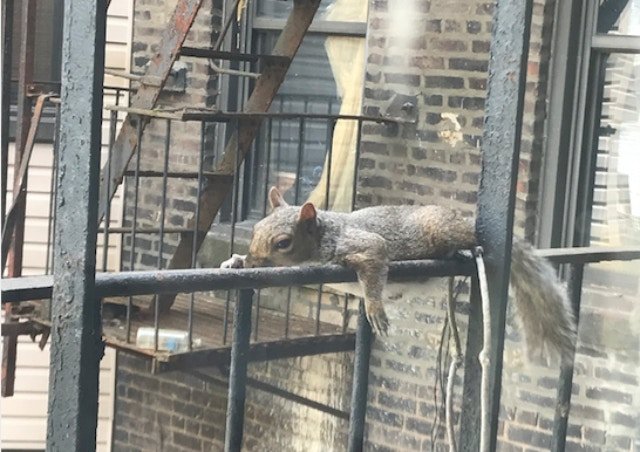The Squirrels Have A Hot Tip For You & It's Called Heat Dumping
July 24, 2019, 2:04 p.m.
Heat dumping is the perfect activity for Hot Squirrel Summer.

This is called "heat dumping."
Yesterday, we received a Hot Tip about a very relatable and very Hot Squirrel, who spent the weekend smashing its rodent stomach into the shade of a Greenpoint fire escape. Its peevish face was arrayed in an expression of resigned exasperation, one that would've been familiar to you, because it was doubtless the same one you wore throughout the blistering heat wave. And/or, because you watch squirrels sprawl across your fire escape all summer long, and have the pics to prove it.
Seen here, a chonkier tree rat, also a resident of Greenpoint:
its chunky cousin in greenpoint says hi pic.twitter.com/xeZHMBFYiP
— Meghan Overdeep (@meghanoverdeep) July 23, 2019
Here's Carl, who lives and lounges in Astoria:
It’s over it step brother in Astoria says hey 👋🏼 pic.twitter.com/MRrQYweHsn
— Yvette Kojic (@yvettekojic) July 23, 2019
Here's Morrissey, a "sad summer squirrel," also from Astoria:
i used to called my sad summer squirrel morrissey 🥵 pic.twitter.com/CBgnhafUCD
— britannie bond (@britanniebond) July 23, 2019
Faced with all this visual evidence, one must wonder: Squirrels, are they interminably lazy or just particularly vulnerable to summertime temps? Did a spate of three-digit heat indices sap these suckers of their will to live, or is this just some regular squirrel shit you'll see year-round if your best emergency egress route is down the spindly staircase clinging to your window?
Intrigued, and mystified, I put the question to cat-and-squirrel researcher Mikel Maria Delgado, PhD, a postdoctoral fellow in animal behavior at the UC Davis School of Veterinary Medicine. Immediately, Delgado identified this prone position as standard Hot Squirrel fare.
"What you are seeing is 'heat dumping,'" Delgado said in an email. "The squirrels are just positioning themselves in a way that most efficiently reduces their body heat—it's been observed in tree and ground squirrels, as well as koalas. So they're just trying to cool down, often by laying on a cool surface!"
A squirrel will typically seek out shady spots in which to heat dump, releasing fiery energy from its body by lying "spread-eagle with [its] belly pressed against the cool ground."
It is, then, a surface area thing, Ben Dantzer, PhD, agrees. An assistant professor in the University of Michigan's Department of Psychology and Department of Ecology and Evolutionary Biology, Dantzer wrote his doctoral dissertation on evolutionary ecology and endocrinology in North American red squirrels. He sees this practice as "analogous" to human heat behavior, like applying a cold washcloth or sitting in a pool, lake, or sprinkler.
"They are just splaying out to try and reduce heat load on their body," Dantzer said. "I notice they typically do this on cool surfaces (tree limbs, under cars, on pavement)."
"Animals that live in seasonal environments (like squirrels in NYC or Michigan, etc.) molt where their hair structure changes," he continued. The hair on squirrels' bellies thickens in winter, creating an insulating undercoat that thins out in the summer. That low-density ab hair, Dantzer said, allows squirrels to "shunt heat away from their body by exposing the closet thing [they have] to a shaved chest."
Emphasis mine.
Or, Dantzer offered, the pancaking could be compared to what "some kids do when they aren't up for their elementary physical education class: you pretend you have to tie your shoes so you can take a brief break to rest." Squirrels may follow a period of intense activity—like say being chased by another, more obnoxious squirrel who won't stop badgering them—with this belly-down refusal to move, which sheds heat from their tiny bodies.
With respect to our local lounge lords, all of this makes sense until you remember that fire escapes are metal, and the weekend rocketed us into the 113-degree stratosphere, and how in the heck is a squirrel or anyone else supposed to stay chill when everything exposed to the elements has warmed to roughly the temperature of lava?
Squirrels reportedly have higher body temperatures than humans do—between 98 and 102, so only slightly higher, sometimes — making them a little more tolerant of the heat than we are. Still, small animals can get heat stroke quickly when left to languish in direct sunlight, but according to Slate, that most often happens when they're cut off from a water source. Squirrels, they report, cool themselves by licking the thinly furred skin of their forearms, and by using their tails for squirrel-specific, temperature-regulating sorcery. They also spend less time rustling around in the underbrush when it's scorching outside, and more time lying motionless at your windowsill, siphoning off the swampy temps as best they know how.
So, if you see me splayed out on your fire escape, basking in the minimal shade with my stomach to the metal bars, you know what I'm doing. I'm heat dumping. I suggest you do the same. (Although I have no idea if this works for humans.)
This story has been updated to include comment from Ben Dantzer.